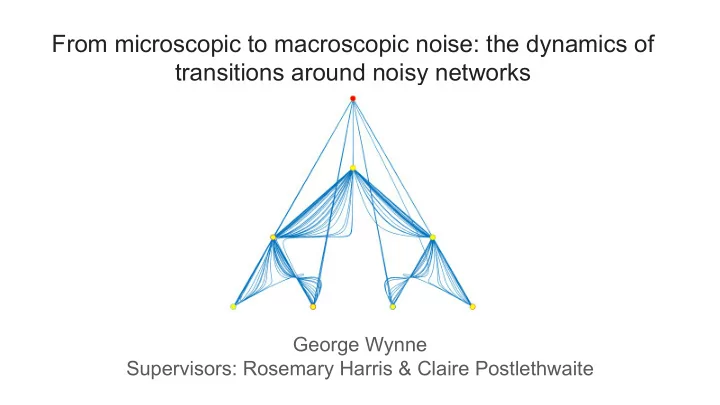

From microscopic to macroscopic noise: the dynamics of transitions around noisy networks George Wynne Supervisors: Rosemary Harris & Claire Postlethwaite
Introduction - We study of heteroclinic networks which are collections of heteroclinic cycles, essentially just the phase space of some ODE. - We then add noise to the ODE and see what happen. - The micro effects are the movement near equilibria, the macro is the sequence of equilibria visited.
Example trajectories - By changing parameters in the below equation we can ‘realise’ a large class of graphs
Example trajectories - Blue points = (+- 1,0,0), Green points = (0,+-1,0), Black points = (0,0,+-1) - Order of equilibria is 1,2,3,1,2,3,1,..... v_{1} v_{3} v_{2}
Local effects from linearising equations - ‘Lift-off’ occurs when the contraction from the previous equilibrium point is weaker than expansion to the next equilibrium point.
OU Simulations - Previous analysis of this lift of assumed the initial value of the outgoing direction was zero. I investigated the effects of it starting at a non-zero value. This is reasonable to investigate since lift-off could have been propagated through the network
Input distribution is positive mean Gaussian, histogram is obtain from simulations of OU process
Macro effects - The micro effects can cause different paths of the network to be explored. - This raises the question of memory effects in the network - Compounding lift-off can get complicated
What was found - Closed form formula for neighbourhood hitting time of exit direction - Integrated this against solution of OU process to get distribution of lift-offs at the time when the particle leaves the neighbourhood - Obtained approximations of its mean & derived equations for the mode of the hitting time distribution. - Obtained noise scaling result of mean lift-off in the context of previous lift-off having occurred in the network.
What still needs to be investigated - Results applying these lift-off effects in more complicated networks with multiple input and output directions at equilibria - Understanding analytic properties of lift-off distribution - Obtaining better approximations for mean lift-off in terms of the noise parameter - Simulations to check whether Gaussian lift-off distribution is valid in more complicated networks
Thank you for listening!
Recommend
More recommend